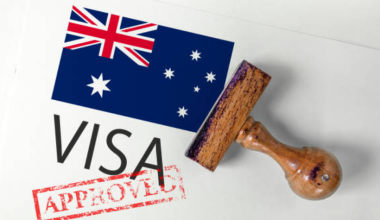International professionals and workers flock to the United States to take advantage of its opportunities.
The USA is a top destination for immigrants seeking work because of its diverse economy, cutting-edge industries, and vibrant multicultural society.
A valid work visa is required for immigrants to work legally in the United States, often with sponsorship from a US-based company.
The purpose of this guide is to provide an in-depth explanation of the different types of work visas, the application process, eligibility requirements for visa sponsorship, and tips for successfully navigating the immigration system.
Why Work in the USA?
The United States has one of the world’s largest and most diverse economies, offering countless career opportunities. Immigrants find the USA an attractive destination for several reasons:
-
Economic Diversity: There are many opportunities in industries such as technology, healthcare, finance, education, and engineering.
-
Career Advancement: Competitive salaries and growth prospects are provided by the US job market, which rewards innovation, hard work, and skill.
-
Global Hub for Innovation: Technological advancements in the USA offer opportunities to work on groundbreaking projects.
-
Cultural Diversity: Multicultural societies provide opportunities for global collaboration and inclusion.
-
Pathways to Permanent Residency: Immigrants can obtain permanent residency through many work visas, making the USA a long-term home.
Types of Work Visas in the USA
There are several types of work visas offered by the USA, each tailored to a specific category of employment. The following are the most common types of work visas:
1. H-1B Visa: Specialty Occupations
-
Professionals in the fields of IT, engineering, healthcare, and finance can benefit from this course.
-
Requires a job offer from a US employer.
-
Cap: 65,000 annually, with an additional 20,000 for advanced degree holders.
2. L-1 Visa: Intra-Company Transfer
-
This is for employees moving to a US office of their existing company.
-
Suitable for executives, managers, or individuals with specialized knowledge.
3. O-1 Visa: Extraordinary Ability
-
For individuals who are exceptionally talented in arts, sciences, education, or sports.
-
A job offer is required as well as evidence of achievements.
4. E-2 Visa: Treaty Investor
-
For investors from countries with trade treaties with the USA.
-
Requires significant investment in a US business.
5. TN Visa: NAFTA Professionals
-
As part of the USMCA agreement, certain Canadian and Mexican citizens are eligible to work in specific professions.
-
Applicants must have a job offer in an eligible profession, such as engineering, law, or education.
6. H-2B Visa: Temporary Non-Agricultural Workers
-
Temporary or seasonal workers in hospitality or construction.
-
Requires employer sponsorship.
7. H-2A Visa: Temporary Agricultural Workers
-
Designed for seasonal agricultural workers.
-
Requires a job offer from a US employer.
8. J-1 Visa: Exchange Visitor
-
Participants in exchange programs such as internships, research, and teaching.
-
Requires sponsorship by a designated US organization.
Eligibility Criteria for U.S.A Work Visas
Depending on the type of visa, there are different eligibility criteria for work visas. Common requirements, however, include:
1. Valid Job Offer
-
A US-based employer’s confirmed job offer is usually required for a work visa.
2. Educational Qualifications
-
A bachelor’s degree or higher in a relevant field is often required for specialized work visas like H-1B.
3. Relevant Experience
-
Extensive experience in the job field or demonstrated expertise.
4. Employer Sponsorship
-
Employers must sponsor most work visa applications, including H-1Bs and H-2Bs.
5. Proof of Non-Immigrant Intent
-
In many cases, temporary work visas require evidence that the applicant intends to return home at the end of the visa period.
Steps to Apply for a USA Work Visa
There are several steps involved in applying for a work visa in the USA. Here’s how it works:
Step 1: Secure a Job Offer
-
Find a US employer willing to hire and sponsor your visa.
-
LinkedIn, Indeed, and Glassdoor are popular platforms for employers to post job openings.
Step 2: Employer Files a Petition
-
Most work visas require the employer to file a petition with US Citizenship and Immigration Services (USCIS).
-
In order to obtain an H-1B visa, the employer must submit Form I-129 (Petition for a Nonimmigrant Worker).
Step 3: Wait for Petition Approval
-
Once the USCIS approves the petition, the employer receives a Notice of Approval (Form I-797).
Step 4: Apply for a Visa
-
Schedule a visa appointment at the nearest US embassy or consulate.
-
Submit Form DS-160 (Nonimmigrant Visa Application) and pay the application fee.
Step 5: Attend the Visa Interview
-
You will need to provide supporting documents, such as your job offer letter, petition approval, and passport.
-
Please provide information about your job role, employer, and intention to apply for a visa.
Step 6: Receive Your Visa
-
Upon approval, your passport will be stamped with your visa, allowing you to work and travel to the USA.
Documents Required for USA Work Visa Applications
The following documents are typically required for a USA work visa application:
-
Valid passport for at least six months beyond your intended stay.
-
Recent passport-sized photographs.
-
Form DS-160 confirmation page.
-
USCIS-approved petition (Form I-797).
-
Employment offer letter.
-
Proof of qualifications (e.g., degrees, certifications).
-
Evidence of work experience (e.g., resumes, letters of recommendation).
-
Visa application fee receipt.
Understanding Visa Sponsorship in the USA
It is crucial to obtain a visa sponsorship to obtain a work visa in the United States. It’s important to know:
1. Employer’s Role
-
Employers act as sponsors, filing petitions and incurring costs.
-
US workers must not be adversely affected by hiring a foreign worker.
2. Labor Condition Application (LCA)
-
H-1B visas require employers to file Labor Condition Applications (LCAs), ensuring the foreign worker receives fair wages and working conditions.
3. Finding a Sponsor
-
Apply to companies with a history of hiring foreign workers.
-
Networking and referrals can increase your chances of finding a willing sponsor.
Cost of USA Work Visa Applications
Work visa costs vary depending on the visa type. Below is a general overview:
-
H-1B Visa:
-
Filing Fee: $460
-
Fraud Prevention Fee: $500
-
Optional Premium Processing: $2,500
-
-
L-1 Visa:
-
Filing Fee: $460
-
Fraud Prevention Fee: $500
-
-
O-1 Visa:
-
Filing Fee: $460
-
Premium Processing (optional): $2,500
-
-
H-2B Visa:
-
Filing Fee: $460
-
In most cases, employers cover these costs, but visa appointments and medical exams may incur additional charges.
Challenges Faced by Immigrants Seeking Work Visas
There are numerous opportunities in the USA, but immigrants often face challenges during the visa application process:
-
There are limited visa quotas for visas like the H-1B, making them very competitive.
-
It can be difficult to find an employer willing to navigate the complicated process of sponsoring.
-
There are strict eligibility requirements, including education and experience requirements.
-
There can be a delay in processing visa petitions and applications for weeks or even months.
-
There is a high cost associated with the visa application process for both employers and applicants.
Tips for Securing a USA Work Visa
-
In-Demand Roles: Concentrate on industries with skills shortages, such as IT, healthcare, and engineering.
-
Using professional networks such as LinkedIn to build connections is one of the most effective ways to network strategically.
-
Showcase your unique skills to differentiate yourself from local applicants.
-
Consult an immigration attorney: Legal experts can help you navigate the complicated visa application process.
-
Stay Persistent: You can succeed if you are determined.
Life in the USA for Work Visa Holders
There are many advantages to living and working in the USA:
-
Gain experience in a global job market that is highly competitive.
-
Salary levels are high across industries, ensuring financial stability.
-
Exposure to diverse cultures and traditions.
-
There are many work visas that provide pathways to permanent residency.
Frequently Asked Questions
1. Can I work in the USA without a visa?
For foreign nationals to work legally in the USA, they must have a valid work visa or authorization.
2. How long does it take to process a work visa?
Processing times vary:
-
H-1B Visa: 3–6 months (Premium Processing: 15 days).
-
L-1 Visa: 1–3 months.
-
O-1 Visa: 2–3 months (Premium Processing: 15 days).
3. Can my family accompany me on a work visa?
The majority of work visas allow dependents (spouses and children) to accompany the employee. The following are some examples:
-
H-1B holders’ dependents can apply for H-4 visas.
-
L-1 holders’ dependents can apply for L-2 visas.
4. Can I switch employers on a work visa?
You can, but the new employer has to file a new petition on your behalf.
5. Are work visa holders eligible for a Green Card?
H-1B and L-1 work visas provide pathways to permanent residency.
Immigrants seeking work opportunities continue to choose the USA because of its wide range of career opportunities and opportunity to build a successful life.
The process of obtaining a work visa can be challenging, but with the right preparation, an understanding of visa types, and perseverance you can succeed.
If you’re a professional, an entrepreneur, or a seasonal worker, the USA provides you with a platform to advance your career.
If you meet the eligibility criteria and take advantage of visa sponsorship opportunities, you can start your path to a fulfilling career in the United States.






1 comment